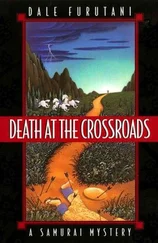Dale Furutani - The Toyotomi Blades
Здесь есть возможность читать онлайн «Dale Furutani - The Toyotomi Blades» весь текст электронной книги совершенно бесплатно (целиком полную версию без сокращений). В некоторых случаях можно слушать аудио, скачать через торрент в формате fb2 и присутствует краткое содержание. Год выпуска: 2012, Жанр: Криминальный детектив, на английском языке. Описание произведения, (предисловие) а так же отзывы посетителей доступны на портале библиотеки ЛибКат.
- Название:The Toyotomi Blades
- Автор:
- Жанр:
- Год:2012
- ISBN:нет данных
- Рейтинг книги:4 / 5. Голосов: 1
-
Избранное:Добавить в избранное
- Отзывы:
-
Ваша оценка:
- 80
- 1
- 2
- 3
- 4
- 5
The Toyotomi Blades: краткое содержание, описание и аннотация
Предлагаем к чтению аннотацию, описание, краткое содержание или предисловие (зависит от того, что написал сам автор книги «The Toyotomi Blades»). Если вы не нашли необходимую информацию о книге — напишите в комментариях, мы постараемся отыскать её.
The Toyotomi Blades — читать онлайн бесплатно полную книгу (весь текст) целиком
Ниже представлен текст книги, разбитый по страницам. Система сохранения места последней прочитанной страницы, позволяет с удобством читать онлайн бесплатно книгу «The Toyotomi Blades», без необходимости каждый раз заново искать на чём Вы остановились. Поставьте закладку, и сможете в любой момент перейти на страницу, на которой закончили чтение.
Интервал:
Закладка:
When Cathy got home, there were two police cars and four police officers waiting. A female police officer pulled Cathy aside and said to her, “We want you to enter your apartment to see what’s missing. Please don’t touch anything because we want to dust for fingerprints.” The officer hesitated a moment, then said, “You might want to prepare yourself for a few seconds before you go in. I’ve been inside and they pretty well trashed your apartment looking for valuables. Things are thrown everywhere and it’s a complete a mess, so watch where you step.”
Cathy braced herself and stepped into an apartment with clothes and other belongings tossed on the floor and spread around the apartment. Then she had to brace herself a second time to tell the police officers that nothing was missing and that was how she normally kept her apartment.
I started laughing and said, “That story about Cathy was the reason I cleaned things up before I left for Japan. I thought if anybody did go into the apartment, I didn’t want to be accused of felony sloppiness. So there was no burglar after all?”
“I guess not. I think Mrs. Hernandez must be losing it. She rousted me out of a sound sleep for no good reason.”
“That’s very strange. She’s usually very accurate. She acts as a one-woman neighborhood watch and not too much goes on that she doesn’t notice. If she said there was a prowler, I’d tend to believe her.”
“She said the prowler got into your apartment, but when we looked, there was absolutely no sign that anyone had been in there. If someone did get into your apartment, they decided there was nothing worth stealing.”
“It’s still strange,” I said.
“So, what’s on the schedule today?” Mariko asked, changing the subject.
“Cheap sightseeing, if I can swing it, and a stop by the studio this afternoon.”
“Well, have fun, and come home safely to me. I love you.”
“I love you, too.”
7
Although News Pop was picking up my tab for travel, hotel rooms, and meals, all sightseeing was to be done on my own nickel. I was still living off the settlement given me when the Calcommon Corporation downsized my job out of existence, so although I could expect a check for a few more months, I didn’t have money to burn.
There’s a large shopping arcade under the Imperial Hotel, and after changing some traveler’s checks for yen in the lobby, I went down to the arcade as my first stop. I passed the fancy art galleries, designer clothing stores, and nice restaurants and made my way to a bookstore. At the bookstore, I bought a good street map of Tokyo and had the clerk circle the location of the Imperial Hotel.
I figured if I got really lost, I could point to the circle on the map and a taxi driver could get me back to the hotel. Of course, that might not always work. I heard a story of a tourist in Tokyo who picked up a matchbook in his hotel’s lobby, figuring that if he ever became lost he could point to the hotel’s name on the matchbook and have the taxi driver take him back to the hotel.
The inevitable happened and the tourist became hopelessly lost. He jumped into a taxi and handed the matchbook to the driver. The driver asked a question in Japanese and the tourist replied in English. It took about two seconds to realize that neither person could speak the other’s language. The tourist kept pointing to the matchbook and gesturing until the taxi driver had a light bulb go on. “Ah!” the driver exclaimed and he started driving. The tourist settled back in the cab and relaxed while the driver drove for about thirty minutes.
Suddenly the taxi came to a stop in an industrial neighborhood that was totally unfamiliar to the tourist. He was trying to figure out where he was while the driver proudly pointed to a building in front of the cab. The tourist looked out of the cab and saw a factory building with a big sign on it that said Tokyo Match Company.
My map had a diagram of the large Tokyo subway and rail system on it. One elevated train, the Yamanote line, runs in a huge circle around Tokyo. This circular line is sometimes used in Japan to describe a speaker. If a speaker is a Yamanote, it means he goes around and around and never comes to the point. I thought riding a loop on the Yamanote line would be a cheap way to get a quick tour of the city. I checked my map and decided to walk to a nearby train station, hop on the Yamanote line, and ride it until I had made a complete circle before getting off at the station next to where I got on.
Walking to the train station from the hotel was an interesting experience. I thought that some racial memory might make the streets of Japan familiar, but although I felt oddly comfortable on the streets, Tokyo was as alien to me as Lagos, Nigeria, or Bombay, India would be.
The twisty streets of Tokyo, originally laid out in a way to confound invading armies, also serve to confound invading tourists. The fact that some streets don’t have names also adds to the fun, along with the Japanese custom of assigning numbers based on the sequence that the buildings in a neighborhood were built. Over time, this custom makes it impossible to guarantee that building four is flanked by buildings three and five. For a country normally viewed by the rest of the world as being orderly and systematic, something as simple as trying to find an address illustrates that the Japanese are as illogical and silly as the rest of us.
As I walked along, the people around me seemed to be in a great rush. In Los Angeles, we sort of meander when we walk. In Tokyo, people were very intent on reaching their destination and not intent on enjoying the journey. As I walked along, I wondered if I was doing the gin-bura, or Ginza stroll. In the old days, the samurai would positively swagger, especially on a big public street in the Ginza district, where all the big money lenders, banks, and smartest shops could be found. Now it looked more to me like the Japanese were practicing the Ginza sprint, because I was the only one strolling.
As people scurried past me, they treated me very much like a tree or one of the metal guardrails that seemed designed to keep people from parking on the sidewalk. The bustle was very reminiscent of New York City, but with one big difference. In Tokyo, not one person bumped into me, jostled me, or even gave me a hard look. The schools of people seemed to flow around me like fish around coral.
I made it to the train station, bought a ticket from a machine, and climbed up to the platform. The train was old, but kept up, and for once I had a good time running around in circles. I ended up in the Ginza, near where I started from, and spent the rest of the day exploring the area and wandering through the big department stores.
For lunch I stopped at the restaurant in the Wako department store that looks over the intersection of Chuo Dori and Harumi Dori, the heart of the Ginza. I ate tiny cucumber, butter, and ham sandwiches that had the crusts carefully sliced off and watched the endless ebb and flow of humanity outside the window.
In the crowd, I saw a tall blond tourist making his way across the intersection. His pale skin, straw hair, and lanky body looked totally out of place in the milling crowd of short, dark-haired pedestrians. He was a pale cork bobbing in a sea of black and brown. I realized that the reason I felt comfortable on the streets was because I blended into the crowd perfectly. That’s not always an advantage in Japan. I know another AJA (American of Japanese Ancestry) who frequently comes to Japan on business. He once told me that he liked to walk with tall, blond business associates because the Tokyo drivers will always stop and let a gaijin (foreigner) cross the street. Because he looked Japanese, my friend was cut no slack by Tokyo drivers, and he was expected to be nimble and watch out for himself when crossing the road.
Читать дальшеИнтервал:
Закладка:
Похожие книги на «The Toyotomi Blades»
Представляем Вашему вниманию похожие книги на «The Toyotomi Blades» списком для выбора. Мы отобрали схожую по названию и смыслу литературу в надежде предоставить читателям больше вариантов отыскать новые, интересные, ещё непрочитанные произведения.
Обсуждение, отзывы о книге «The Toyotomi Blades» и просто собственные мнения читателей. Оставьте ваши комментарии, напишите, что Вы думаете о произведении, его смысле или главных героях. Укажите что конкретно понравилось, а что нет, и почему Вы так считаете.












